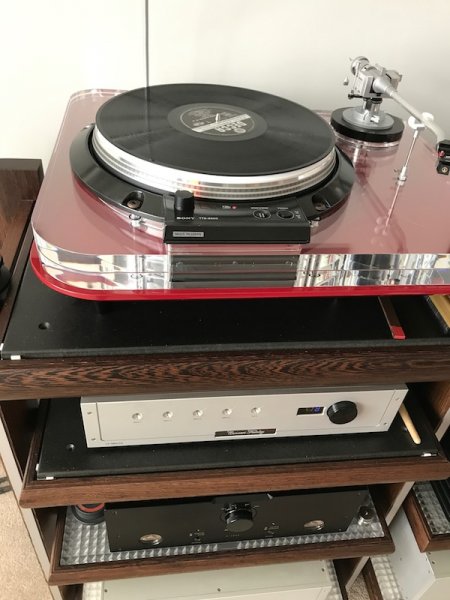All, absolute epiphany. UK Paul can corroborate.
I went to UK Paul's place (just outside London) to listen to his heavily modded Martin Logan spires with concert fidelity electronics. He has added Clarity and Duelunds to the crossovers, taken out the woofers from those boxes and placed them separately to the panel, and heavily damped the panel for vibration control.
Since liking Apogees I have found MLs thinner, less bodied and organic to the apogees. Recent demos at shows and dealers with all SS gear like Constellation have made them sound quite disappointing, thin, anemic, and a bit plastic like.
So after going to Paul's and listening to a few tracks, We first switched over to the Lampi. After trying 242 (too clean and overdrove his pre to distortion) and special 45s (which sounded a bit wispy in that set up), we settled on Kr audio PX25s - with them in, there was loads of energy, drive, full body to each instrument, great body and tone on strings, flutes, oboes, etc.
More importantly, the sound was denser, bass was deeper in stage - the tympani would really kick in from behind, and across the space. Bass should exist in space, not in a woofer inside a speaker. The speakers had merged into a plane instead of music coming each speaker separately. Much more space between the instruments yet dense. The baritone now had a chest like on an Apogee, instead of being lean in the 100 - 200hz region. There was fantastic decay adding to the musicality
With Cecilia Bartoli, Paul used the words "she is floating towards us like an angel" and "her noise floor is just so low". This was because even on softer passages, even at low volumes, there was a lot of drive, and microdynamic energy, that led to music swells and the music flow.
Bach Canata chorus staged perfectly with musical decay, and Gnomus was dynamic, energetic, well separated, with each instrument showing proper tone and decay. Old Castle had energy and drive even through the soft brass and wind movements, extremely involving.
When we shifted to Analog (Sony TS 8000 direct drive, restored by Paul, with an SAEC arm and Art 9 cart through the Allnic 3000 phono), the music again lacked a bit of drive and tone. I remember preferring Zesto to the stock Allnic 3000 (which just seemed to beautify the top), and Myles had then said that the Allnic phono is recti sensitive. I remembered that and realized my KR recti works in it, so we switched the recti, put in my KR Audio 5u4g. Boom! the magic was back - even better. Loads of drive, energy, bloom, body, decay, dynamics.

Bruch violin had better tone and the orchestra was more spread out, Emperor had more floor, explosiveness, and energy in the piano strikes, and Scheherazade 4th movement was just dynamic with excellent slams, speed, and drive, and front to back depth. When we played the below LP, there is a part where the performers clap in chorus...with the KR recti on, we felt like getting involved and clapping and joining in...with the stock recti and the Philips, it was just some distant music being played in a laid back fashion, without any drive, impact, or clarity or dimension.

Personally, this is my favorite (relatively) low budget medium room system, leaving out all out assaults and exotic giant speakers (Apogee Grands, Yamamuras, other big horns), probably slightly pipping Lissnr's apogee duetta system which has a slightly smaller room. I understand some room dimensions here and there as well as electronics changes can shift the balance, but used spires (with Ethos and Montis) are just so low cost and with easy resale, this is a no brainer. MLs along with Apogees are extremely sensitive to electronics and show very high variance that can make or break the system. The valve dac and phon with hybrid pre and 200w SS Concert fidelity amp worked perfect. So if you are listening to an ML at a show that is thin, anemic, lean, ignore it and walk away. It needs the density, then it sounds like ribbons but with more coherence and details. Here there was just total transparency, as if there was no speaker there, music coming from the walls, just front to back depth of the size of a small stage, properly proportional to the room. Yes, brass will have more density and grunt on ribbons and piano will have fuller tone, Kick drum and tympani like impact will be shockingly good on Apogees, and rock will be better on the ribbons too. But decay, coherence, details, and musicality is easier to get on this
This system is straight into my category of "yes, you can improve on this if you spend a lot more in the right room and if your effort clicks and all pieces fall together, but the majority might be better off just simply enjoying this set up". Nothing fancy with the room, just good length and width. There is even glass behind and an uneven front wall, yet that did not seem to matter.
I would really be interested in listening to a good valve CLX set up to see how it manages the bass without the hybrid woofer. Chatting with awsmone, one can bump up the mid bass by 3db in the crossover, he has 5 subs in a massive room, and runs them on valves. This calls for a Martin Logan deep dive.





